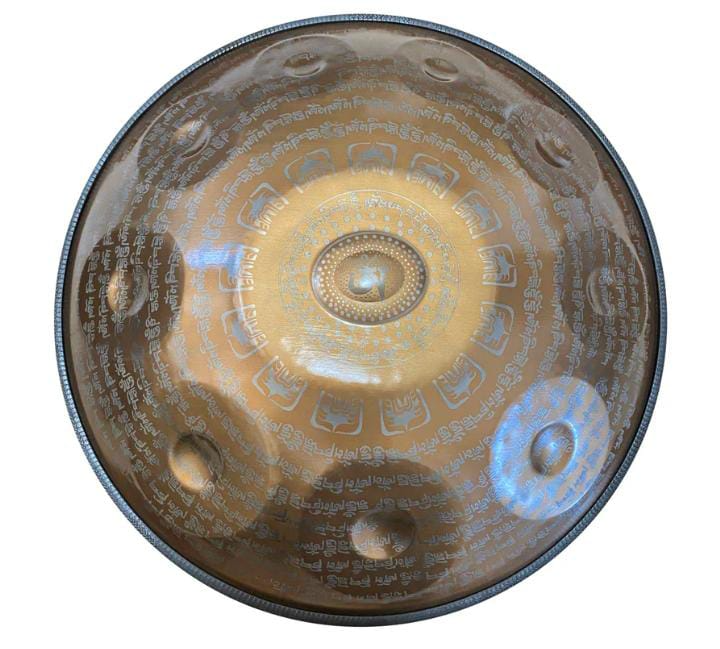
The handpan is a modern musical instrument that has captured the hearts of musicians and listeners alike with its serene and melodic tones. Whether you're a seasoned player or exploring "handpan for sale" options as a beginner, understanding how this fascinating instrument works is essential to appreciating its beauty and craftsmanship.
The hardpan's history is deeply rooted in Trinidad and Tobago's Caribbean steel drum, or steel pan. This traditional instrument inspired the creation of the hang in 2000. In Bernese German, the word " hang " means "hand" and “hillside" alike, which captures the instrument's organic relationship with nature and its one-of-a-kind way of playing.
The hang was conceived as a hybrid in that its tonal characteristics resemble the steel pan, blending the elements of the Indonesian gamelan, Thai gong, and Indian ghatam. But it was designed to be a hands-on instrument, meant for the hands playing it, thus allowing musicians in pursuit of a more intimate and tactile musical experience to build their hybrid noninstrument. Over the years, the hang evolved into what we now know as the handpan, an instrument that continues to inspire musicians worldwide.
The handpan is a carefully designed idiophone, an instrument that produces sound through its own vibration without the use of strings, membranes, or air. Constructed from two convex steel shells, the handpan resembles a flying saucer. Collectively, their shells join to form a hollow body of sound that plays beautifully.
The Ding is a dome in the center of the top shell that produces the instrument's root or bass note. Around the Ding are several indented tonal fields tuned to specific notes within a chosen scale. This arrangement ensures that all notes harmonize, making it an ideal choice for "handpan beginners" looking to experiment without fear of discordant sounds.
The underside of the handpan contains an opening known as the Gu. This opening amplifies the instrument's resonance, contributing to the warm, meditative tones that define the handpan's sound. Merging these variables results in an instrument adaptable to many environments, making simplicity and complexity coexist.
When a handpan drum is played, sound is produced by gently striking the steel surface with the hands or fingers. Each instrument's tonal field is tuned to a fundamental note and its harmonics, giving the handpan its rich and layered sound. There are quite a few other options for variation in tone, from soft, resonant notes to sharper, percussive accents using different parts of their hands.
Comprising the Ding, the Ding is the root note that lends a bass-like resonance to the sound of the instrument itself. The surrounding tonal fields allow for melodic improvisation within the handpan's scale. Unlike many instruments that require precise technique to avoid dissonance, the handpan's design ensures that all notes blend harmoniously. It especially appeals to beginners who want to think about creativity and expression, not technical challenges.
The handpan offers a gentle introduction to creating melodies for those new to music. Its intuitive design and harmonic tuning allow "handpan beginners" to produce beautiful music with minimal effort. Unlike traditional drums that demand advanced coordination, the handpan focuses on rhythm and timing, making it accessible even to those without prior experience.
Additionally, the tactile nature of the handpan encourages exploration. Experiment with striking different areas of the instrument to find several distinct tones and timbres. This hands-on approach makes learning the handpan both enjoyable and rewarding.
If you've searched for "handpan for sale," you may have noticed the high price range, often starting at $1,000 and reaching over $3,000. This cost reflects the intricate craftsmanship required to create each handpan. Unlike mass-produced instruments, handpans are meticulously handcrafted by skilled artisans who perfectly shape and tune each tonal field.
The process of building a handpan is labor-intensive, often taking several months. The tuning of a note and the thickness of steel are a small detail among the many details that make every instrument sound unique. This dedication to quality ensures that a well-made handpan drum will provide years of musical enjoyment.
Each handpan is tuned to a specific scale, such as major, minor, or harmonic minor. In other words, the notes are placed in a way that a theyrformusical palette. Although this setup deprived the instrument of one scale, it quickly made improvisation more feasible and predictable by obliterating "wrong" notes. Multiple handpans tuned to complementary scales can be played together for musicians who desire more versatility.
The choice of scale is an important consideration when purchasing a handpan. Start with popular options such as D minor or Celtic scales that enable notes for melody and rhythm by combining a good mix of the diatonic notes in a balanced arrangement.
The rising popularity of handpans has led to an increase in availability, with many "handpan for sale" options both online and in physical stores. Reputable vendors like Amazon, Yatao Handpan Shop, and specialized makers like Cosmos Handpan offer various instruments to suit different needs and budgets.
If you're curious about the handpan's sound, attending workshops, festivals, or visiting stores where you can try the instrument in person is highly recommended. Besides, many professional players also put their songs on the Internet to inspire and give real clues to beginners.
The handpan is a modern marvel that combines innovation with tradition. With its roots, thought, and intuition built into the design and play, it's an instrument that draws the musicians who play it and the listeners who hear it. For "handpan beginners," it offers a welcoming entry point into the world of music, while its depth and versatility keep even experienced players engaged.
Whether you're exploring "handpan for sale" options or intrigued by its enchanting sound, the handpan invites you to discover a world of creativity and connection. A true masterpiece of modern musical craftsmanship, this design's uniqueness, rich harmonics, and meditative tones make it a must-have for any Psycho musician.